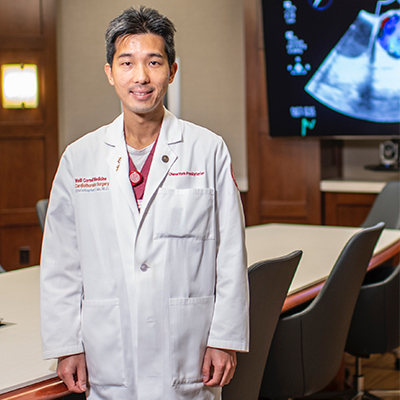Retrograde Cerebral Perfusion: Heightening Protection During Aortic Arch Surgery
A major concern in aortic surgery is maintaining circulation to the brain throughout the procedure, particularly when performing an arch aneurysm repair. “Cerebral protection is extremely important during aortic arch surgery because the carotid arteries stem from the aortic arch to supply blood to the brain. Therefore, when we work on that part of the aorta, the normal blood flow to the brain is interrupted and we need to employ adjunctive techniques to protect the brain from ischemia,” says Christopher Lau, MD, aortic surgeon and Director of Endovascular Surgery in the Department of Cardiothoracic Surgery at NewYork-Presbyterian/Weill Cornell Medical Center and Weill Cornell Medicine.
Dr. Christopher Lau
Different approaches are used to provide cerebral protection during aortic surgeries, and the cardiothoracic surgery team at NewYork-Presbyterian/Weill Cornell has closely evaluated these procedures. These include retrograde cerebral perfusion, which has become their procedure of choice confirmed by a study the team conducted to determine its effectiveness for prolonged circulatory arrest in arch aneurysm repair. Their findings, published in The Annals of Thoracic Surgery, confirmed that retrograde cerebral perfusion as an adjunct to deep hypothermic circulatory arrest is effective for cerebral protection during aortic arch repair and complex arch reconstruction surgeries requiring circulatory arrest for as long as 60 minutes or more.
“Aortic arch surgery was first performed with deep hypothermic circulatory arrest, which basically cooled down the entire body, including the brain, to about 18 degrees Celsius,” explains Dr. Lau. “This minimizes the metabolism of all of the tissues, especially in the brain. The colder it is, the lower the metabolism of the cells becomes. At this temperature, you can stop the circulation for about 30 minutes of safe time before cell damage develops from lack of oxygen. Additionally, the metabolism of all the organs remains low, which results in very low rates of kidney and liver problems.”
“We still use deep hypothermic circulatory arrest,” continues Dr. Lau, “but we have added on retrograde cerebral perfusion. With this approach, we position our bypass circuit in a way that the blood flows backwards through the superior vena cava and into the brain. This allows us to send blood up to the brain without the need for numerous catheters in the aortic arch, improving visualization as we work on the aortic arch and the carotid arteries even though we’re actively perfusing the brain itself through the veins. The blood that is delivered in this manner is very cold, about 4 degrees Celsius, keeping the brain even cooler than the 18 degrees achieved with hypothermic circulatory arrest and allows for up to 60 minutes of prolonged circulatory arrest.”
Leonard N. Girardi, MD, Chair of Cardiothoracic Surgery, and his colleagues at Weill Cornell Medicine had previously established the safety and efficacy of retrograde cerebral perfusion as an adjunct for cerebral protection. Their study published in the December 2014 issue of The Journal of Thoracic and Cardiovascular Surgery demonstrated that patients requiring periods of cardiac arrest of 50 minutes or longer did not have a greater risk of permanent neurologic deficits.
In the current study by the Weill Cornell Medicine research team, aortic arch reconstruction with deep hypothermic circulatory arrest (DHCA) at 18 degrees Celsius and retrograde cerebral perfusion was performed in 1,043 patients. Of these patients, 993 had a DHCA time of 49 minutes or less and the remaining patients had a DHCA of 50 minutes or more.
Dr. Lau notes that another benefit of retrograde cerebral perfusion is that it pushes out any debris floating within the cerebral vasculature during circulatory arrest, thereby cleansing the carotid arteries of any loose debris. “When we are finished repairing the arch of the aorta, the risk of cerebral emboli is decreased significantly. We think that this incidental cleaning out of debris minimizes the risk of stroke, which usually translates to lower mortality and fewer complications down the line.”
While antegrade cerebral perfusion is also commonly used for cerebral protection, Dr. Lau and his colleagues prefer the retrograde approach. “Antegrade cerebral perfusion requires separate catheters that perfuse the carotid arteries to the brain when you stop the circulation to the body,” says Dr. Lau. “While the results are very similar for both procedures, patients with the antegrade approach may develop more lower body ischemia issues affecting, for example, liver and kidney function when circulatory arrest is prolonged. At Weill Cornell, we have shown that using retrograde cerebral perfusion has achieved outstanding results, including a stroke rate that is less than 1 to 2 percent.”
A Molecular Validation for Retrograde Perfusion
Studies of retrograde perfusion in animal models have indicated that perfusion via the superior vena cava may not reach the brain. With this backdrop, Dr. Lau and his colleagues at Weill Cornell Medicine conducted a proof-of-concept study looking at a specific molecule, S-100β, as a marker of circulation in the brain parenchyma. This protein has very high neuro-sensitivity and is produced almost exclusively in the brain.
“We measured this molecule in the blood before it entered the superior vena cava and then again in the blood returning from the carotid arteries during retrograde cerebral perfusion,” says Dr. Lau. “We found that the longer a patient was on circulatory arrest, the greater the amount of the S-100β molecule. This showed us that using the retrograde approach is enabling oxygenated blood to reach the tissue of the brain itself, despite what has been shown in an animal model.”
“We continue to use the combination of deep hypothermic circulatory arrest and retrograde cerebral perfusion for aortic arch repair and all type A dissections, most of which require circulatory arrest,” says Dr. Lau. “Our mortality rate for surgery in more than 340 patients with type A dissections, which is normally a very high risk procedure, was 4.5 percent compared to mortality rates of 18 to 25 percent identified in the International Registry of Aortic Dissection database. The results we achieve with retrograde cerebral perfusion have been so good that we do not plan to change the way we do circulatory arrest at this point.”
Read More
Retrograde Cerebral Perfusion Is Effective for Prolonged Circulatory Arrest in Arch Aneurysm Repair. Lau C, Gaudino M, Iannacone EM, Gambardella I, Munjal M, Ohmes LB, Degner BC, Girardi LN. The Annals of Thoracic Surgery. 2018 Feb;105(2):491-497.
Retrograde perfusion through superior vena cava reaches the brain during circulatory arrest. Gaudino M, Ivascu N, Cushing M, Lau C, Gambardella I, Di Franco A, Ohmes LB, Munjal M, Girardi LN. Journal of Thoracic Disease. 2018 Mar;10(3):1563-1568.
Safety and efficacy of retrograde cerebral perfusion as an adjunct for cerebral protection during surgery on the aortic arch. Girardi LN, Shavladze N, Sedrakyan A, Neragi-Miandoab S. The Journal of Thoracic and Cardiovascular Surgery. 2014 Dec;148(6):2927-33.
Related Publications






